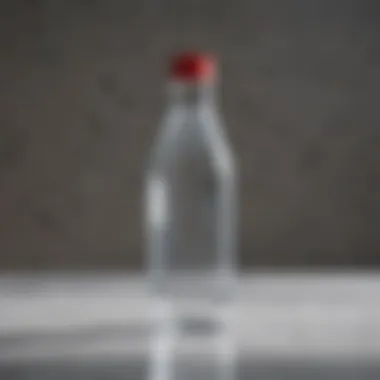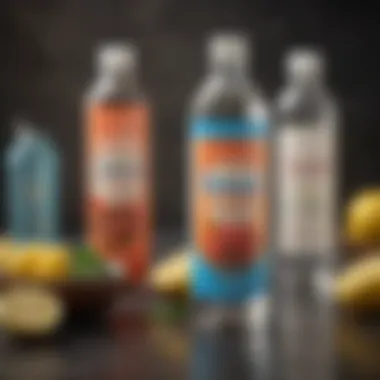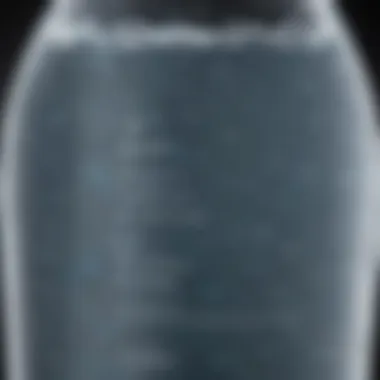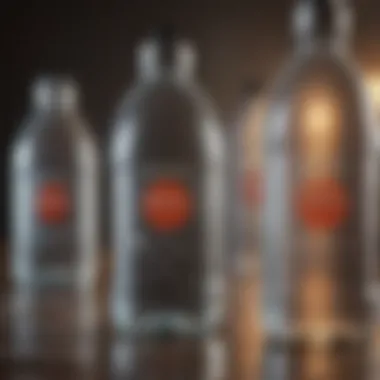Sanitizing Water Bottles: Essential Practices for Health


Intro
In today’s health-conscious world, the cleanliness of our drinking vessels is paramount. Many individuals use water bottles daily, whether for exercise, work, or simply staying hydrated. However, these containers can harbor harmful bacteria and germs if not cleaned regularly. This highlights the need for proper sanitization practices. In this article, we will explore effective methods for sanitizing water bottles, emphasizing their importance for health and safety. Regular sanitation not only ensures that your water is clean but also protects you from potential illnesses.
Understanding how to maintain these essential items is crucial for anyone invested in their well-being. Whether you are a busy professional or an active individual, learning about the practices of keeping your water bottle safe and clean enhances your overall health regimen. Let us break down some essential ways to achieve effective sanitization.
Understanding Contaminants in Water Bottles
Understanding the various contaminants that can reside in water bottles is crucial for maintaining health and safety. Water bottles can harbor harmful substances that affect the quality of the water we drink. By being aware of these contaminants, individuals can take proactive steps to sanitize their bottles effectively. This comprehensive understanding can lead to better choices regarding cleaning methods, ultimately fostering improved well-being.
Types of Contaminants
Bacteria
Bacteria are microscopic organisms that can proliferate in water bottles, especially if they are not frequently cleaned. They can multiply rapidly, leading to potential health risks. Most notably, bacteria such as E. coli or Salmonella are common contaminants. Their presence signals inadequate sanitation and problematic health implications. Bacteria in water bottles can lead to gastrointestinal distress and other short-term ailments, making their identification vital for users aiming to maintain cleanliness.
Viruses
Viruses are another significant group of contaminants often overlooked. Unlike bacteria, which can reproduce outside a host, viruses require a living host to replicate. Contamination can occur through unwashed hands or shared bottles. Common waterborne viruses, such as Norovirus, can cause significant health problems. Their resilience makes them challenging to eliminate, requiring more stringent cleaning measures than those typically employed against bacteria. Understanding how viruses contaminate water bottles underscores the importance of personal responsibility and hygiene practices.
Mold and Mildew
Mold and mildew thrive in damp environments, making water bottles an ideal breeding ground. These fungi can release spores that contaminate water, posing serious health risks, including allergies and respiratory problems. Mold can develop even in small amounts of residual water left in a bottle. Regularly inspecting bottles for signs of mold growth and taking corrective action is essential. Not only can these fungi ruin the taste of water, but their presence indicates a lack of proper sanitation procedures.
Chemical Residues
Chemical residues can accumulate in water bottles from various sources, including the bottle material itself or water that is stored for extended periods. Common chemical contaminants might include BPA from plastic bottles or residues from cleaning agents. These chemicals can leach into the water, posing both short and long-term health risks. Understanding the types of materials used in the construction of water bottles will help consumers make informed choices and reduce possible exposure to harmful substances. Engaging with safer alternatives can mitigate potential adverse health impacts.
Effects on Health
Short-term Illnesses
Short-term illnesses resulting from contaminated water bottles can manifest as mild to severe gastrointestinal issues. These conditions can range from nausea to more severe ailments, disrupting daily activities. While such illnesses are often temporary, they can significantly impact an individual’s productivity and overall quality of life. Awareness of the phenomenon and the sources is strategically important for maintaining optimal health in active individuals.
Long-term Health Risks
Long-term exposure to contaminants in water bottles can lead to chronic health issues. Regular consumption of contaminated water could result in ongoing health concerns, complicating one's overall health trajectory. Some pathogens can alter food absorption and promote illness over time, leading to increased susceptibility to infections and diseases. The awareness surrounding these risks bolsters the case for diligent sanitation practices as a preventative measure.
Why Regular Sanitization is Important
Sanitizing water bottles is crucial for ensuring health and safety. Water bottles can easily become breeding grounds for bacteria, viruses, and mold if not cared for properly. Regular sanitization can help to lessen the risk of illnesses, especially considering how often many individuals use their bottles throughout the day.
Frequent cleaning is more than just a good practice; it is a necessity. The likelihood of contaminants increases with every sip, especially when sharing bottles or during outdoor activities. Understanding the right ways to maintain and clean these vessels can protect your well-being and enhance your hydration experience.
Frequency of Use


The more often a water bottle is used, the greater the need for regular sanitization. Daily usage means constant exposure to the mouth and environment. As a result, bacteria and other harmful microorganisms can quickly accumulate. Regularly cleaning your bottle helps to keep it hygienic and minimizes the chance of developing any health-related issues.
A personal water bottle should be cleaned at least once a day if it is frequently used. This is particularly vital for those who exercise or spend time outdoors, where the risk of contamination rises.
High-risk Environments
Outdoor Activities
Outdoor activities, such as hiking or biking, often expose water bottles to nature and dirt. Dust, pollen, and moisture can easily settle on or inside the bottle. This exposure may encourage the growth of organisms that could lead to health issues, making sanitation essential. Many people enjoy outdoor sports and adventures, which require hydration. Thus, knowing how to properly sanitize water bottles becomes significant for enthusiasts. The unique challenge is maintaining cleanliness while engaging in challenging activities.
Shared Spaces
Shared spaces also heighten the risk of contamination. Using water bottles in places like gyms, schools, or workplaces can increase exposure to germs. When users borrow or share bottles, harmful bacteria and viruses can transfer. Therefore, it is vital to sanitize regularly in these environments to prevent spreading illnesses. The key characteristic of shared spaces is the frequency of contact among individuals, making it important to establish solid hygiene rules for bottle use.
People in urban settings or communal areas must be aware of these risks when using their bottles. Maintaining a clean water bottle while sharing spaces is not just about individual health; it contributes to overall community health as well.
Regular sanitization of water bottles in high-risk environments protects not only personal health but also public health.
By understanding these elements, individuals can take proactive measures in cleaning their water bottles and reducing the chance of health risks.
Methods for Sanitizing Water Bottles
Sanitizing water bottles is essential to ensure that they remain free from harmful pathogens and contaminants. With countless individuals relying on these vessels for daily hydration, it is vital to adopt effective techniques for cleaning. Each method caters to specific needs and preferences, ensuring comprehensive hygiene that aligns with various lifestyles. Regular sanitization not only protects health but also extends the longevity of the bottle itself. This section will explore several methods, highlighting their features, advantages, and limitations.
Using Soap and Water
Choosing the Right Soap
Choosing the right soap is critical for effective cleaning. Not all soaps are suitable for cleaning water bottles, as some may leave residues or contain harsh chemicals. A mild dish soap is often a reliable choice. Its key characteristic is its ability to break down grease and remove food particles without leaving harmful residues. This makes it popular amongst health-conscious individuals looking for an effective yet safe cleaning solution.
While commercially available dish soaps are effective, users must always check for any allergies to ingredients. Some soaps can be overly fragrant, which may leave an undesirable taste if not rinsed properly.
Process for Effective Cleaning
The process for effective cleaning involves a few simple yet crucial steps. First, fill the bottle with warm water and add a few drops of the chosen soap. Shake the bottle vigorously. This action helps in loosening particles stuck to the walls. Additionally, using a bottle brush to reach the bottom can enhance the cleaning process. This method is beneficial as it targets potential trouble spots where bacteria can accumulate. After a thorough rinse, allow the bottle to air dry completely before using it again, as moisture can promote bacterial growth.
Utilizing Vinegar and Baking Soda
Benefits of Natural Cleaners
The benefits of natural cleaners like vinegar and baking soda are gaining popularity in today's health-conscious society. These two ingredients offer a non-toxic alternative to chemical cleaners, effectively killing germs and neutralizing odors. Their key characteristic lies in their natural disinfecting properties, making them an appealing choice for those concerned about synthetic chemicals.
Vinegar's acidity helps break down mineral deposits and odor, while baking soda acts as a mild abrasive. The combination of these natural cleaners is an attractive option for individuals aiming for a safer cleaning approach. However, they may not eliminate every pathogen, making regular cleaning necessary.
Application Techniques
The application techniques for vinegar and baking soda are straightforward. To start, pour 1 cup of vinegar into the bottle, followed by 2 tablespoons of baking soda. The reaction will create fizzing, which helps lift dirt and grime. After the fizzing stops, let the solution sit for about 30 minutes before rinsing thoroughly. This method is beneficial because it utilizes common household items, making it convenient and cost-effective. However, users must remember that this method requires proper rinsing to avoid any lingering taste.


Bleach Solution Method
Safety Precautions
When considering the bleach solution method, safety precautions cannot be stressed enough. Bleach is an effective sanitizer, but it poses several risks. It should never be mixed with other cleaning agents, as this can produce harmful gases. The key characteristic of using bleach is its ability to kill bacteria and viruses effectively. However, individuals must wear gloves and ensure proper ventilation when working with it.
It’s important to note that bleach can be harsh and may damage some materials over time, especially plastics. Thus, one must consider the type of bottle material before employing this method.
Preparation of Solution
Preparation of the bleach solution requires careful measurements. A general guideline is to mix one tablespoon of unscented household bleach with one gallon of water. This diluted solution is potent enough to sanitize effectively. After applying it to the bottle's interior, let it sit for about two minutes, followed by a thorough rinse with clean water. This method is efficient for deeply contaminated bottles, though thorough rinsing is crucial to remove bleach residues, which can be harmful.
Commercial Sanitizers
Types Available
The types of commercial sanitizers available can vary significantly, each designed with different features and focuses on effectiveness. Many are classified as portable sprays or wipes that claim to eliminate 99.9% of germs. Their convenience makes them popular for on-the-go sanitization. The primary characteristic of these sanitizers is their reliance on alcohol or other antimicrobial agents.
While they are easy to use, one must assess the ingredients and ensure they are suitable for food-related items to avoid unwanted health effects or taste alterations.
Proper Usage Instructions
Proper usage instructions for commercial sanitizers are important to ensure maximum effectiveness. Generally, users should spray or wipe the sanitizer inside the bottle and let it sit for the time specified on the label, usually a few minutes. It is necessary to rinse the bottle afterward, especially if using a high-alcohol product. This helps eliminate any lingering residues. Commercial sanitizers offer a time-efficient solution, ideal for busy routines. Their drawback, however, lies in the necessity to read labels carefully to avoid unsuitable ingredients.
Tips for Maintaining Clean Water Bottles
Maintaining clean water bottles is a critical aspect of overall health and hygiene. Water bottles can harbor bacteria, mold, and other contaminants if not properly sanitized. Establishing good habits can significantly reduce these risks and improve safety for daily use. Incorporating simple yet effective cleaning practices into your routine enhances not only the longevity of the bottle but also supports your health by ensuring that the water you drink remains uncontaminated.
Daily Cleaning Habits
Daily cleaning habits are essential in preventing the build-up of harmful substances inside water bottles. After each use, it is advisable to rinse the bottle with warm water to remove any residue. A quick rinse is often not sufficient, as some microorganisms can withstand low rinsing temperatures. Thus, you should aim to clean your bottle more thoroughly at regular intervals. This includes scrubbing the inner surfaces with a bottle brush and a suitable cleaner, preferably soap.
Using hot, soapy water for cleaning is one of the most straightforward methods. Make sure to focus on the neck and underside of the lid, areas that can be particularly prone to deposits. Additionally, letting the bottle air dry after cleaning can prevent moisture from lingering, as moisture often promotes mold growth.
Choosing the Right Water Bottle Material
The material of your water bottle influences its cleaning requirements and hygiene properties. Each type of material has its own advantages and disadvantages.
Plastic
Plastic water bottles are widely used due to their lightweight nature and convenience. However, not all plastics are created equal. Generally, certain types of plastics can retain odors and stains from previous liquids. Choosing BPA-free plastics is important, as bisphenol A can leach into the water, posing potential health risks.
A unique feature of plastic is its durability in terms of impact resistance. This characteristic can be considered advantageous if you often carry the bottle on outdoor activities. Nonetheless, plastic bottles should be cleaned regularly to avoid the build-up of bacteria and must be replaced periodically, as wear and tear can lead to cracks that harbor germs.
Glass


Glass bottles are a popular choice for those who prefer a more eco-friendly and chemical-free option. They do not leach any substances into the water, assuring a purer drinking experience.
The transparency of glass allows users to easily check for residues and dirt. The downside, however, is their fragility; great care is necessary to prevent breakage, particularly during outdoor adventures. Glass can also be heavier than plastic, but many find this trade-off justifiable due to health considerations. Regular cleaning with soap and water, or even running through a dishwasher, keeps glass bottles sanitized and ready for use.
Stainless Steel
Stainless steel water bottles are celebrated for their insulating properties; they keep drinks cold or hot for extended periods. They are typically more durable compared to both plastic and glass, making them a favorable choice for active lifestyles.
A key feature of stainless steel is its resistance to rust and corrosion. This ensures that no metallic taste affects the water quality. However, when utilizing stainless steel, it is essential to ensure you are using an appropriate cleaner, as abrasive materials can scratch the bottle's surface. Regular cleaning with soap and rinsing afterward helps maintain hygiene.
In summary, each material has unique properties that contribute differently to both health and cleaning practices. It is vital to select a water bottle that meets your lifestyle needs while also allowing for effective sanitization practices.
Environmental Considerations
The importance of environmental considerations in sanitizing water bottles cannot be underestimated. Each choice we make about the materials we use and the methods we select for cleaning can have long-lasting effects on the planet. As awareness grows around climate change and sustainability, understanding the environmental impact of our habits has become crucial. When it comes to water bottles, this relates first and foremost to the use of plastics.
Impact of Plastic Waste
Plastic waste is a significant issue in today's world. It accumulates in landfills and oceans, threatening wildlife and natural ecosystems. Many water bottles are made from polyethylene terephthalate (PET), which is recyclable but requires specific facilities to be processed. Unfortunately, not all recycling efforts are successful, which leads to millions of plastic bottles being disposed of improperly each year. The durability of plastic means that it can take hundreds of years to decompose, hence reducing the effectiveness of recycling practices. It is therefore important to be mindful of how often we purchase and dispose of plastic water bottles.
"Reducing plastic waste through better practices is essential for a sustainable future. Every small step counts."
Eco-friendly Alternatives to Traditional Bottles
To combat the negative impact of plastic, there are numerous eco-friendly alternatives available today. These options not only provide safer choices for your health but also support sustainability initiatives. Consider the following materials:
- Glass: Durable and easy to clean, glass bottles pose no risk of chemicals leaching into your drink. They are recyclable and do not contribute to plastic waste.
- Stainless Steel: This material is robust, lightweight, and thermally insulated. Stainless steel bottles keep beverages cool and are resistant to bacteria growth.
- Biodegradable Plastics: Some newer bottles are produced from materials that break down more quickly than traditional plastics, offering a bit more environmental security.
When choosing a water bottle, think about your habits and environmental impact. Research shows that switching to reusable bottles can significantly reduce the amount of plastic waste generated by single-use bottles. Taking sustainable actions is important for health, safety, and the health of the planet.
Final Thoughts on Water Bottle Sanitization
Sanitizing water bottles is not merely a suggestion; it is a fundamental practice that intersects health, hygiene, and safety. As individuals increasingly prioritize wellness, understanding the sanitation procedures can make a significant impact on daily life. Clean bottles directly correlate with reducing health risks associated with the consumption of contaminated water or liquids. It reflects an awareness of self-care and environmental responsibility.
Moreover, the benefits of regular sanitization extend beyond individual health. Awareness in proper sanitization contributes to a broader culture of cleanliness that can inspire others. It promotes safe habits in communal spaces, such as offices or schools. The simple act of maintaining a clean water bottle could set a model for others, elevating the conversation about public health.
Certain factors must be considered in this process, including the type of material your bottle is made from, the frequency of use, and the environments in which it's used. Each of these will influence how often a person should clean their bottle and which methods will be most effective.
Summary of Best Practices
To wrap up the discussion, the following best practices should be kept in mind when it comes to sanitizing water bottles:
- Daily Cleaning: Make it a habit to clean your bottle every day using warm soapy water.
- Periodic Deep Cleans: Utilize vinegar, baking soda, or bleach solutions for a more thorough disinfecting process from time to time.
- Material Awareness: Consider the implications of using different bottle materials; some are more susceptible to harboring contaminants.
- Avoid Shared Bottles: Whenever possible, use your own bottle to prevent cross-contamination, especially in shared environments.
- Inspect Regularly: Check for signs of wear or damage; a compromised bottle may not only harbor bacteria but may leak as well.
These practices will assist in ensuring that your water bottle remains a safe vessel for hydration.
Encouraging Safe Habits
Encouraging safe habits is essential for long-term health benefits. These habits must be integrated into daily routines. Here are some ways to achieve this:
- Set Reminders: Use smartphone reminders to keep track of cleaning schedules.
- Lead by Example: Encourage friends and family to adopt similar practices; this reinforces a community standard for hygiene.
- Education: Share knowledge about the importance of clean bottles through schools or community centers to raise awareness among broader audience.
By fostering a culture of cleanliness surrounding water bottles, individuals can contribute positively to their own health and that of those around them. Taking simple yet effective steps toward effective sanitization not only benefits personal health but also supports overall community wellness.







